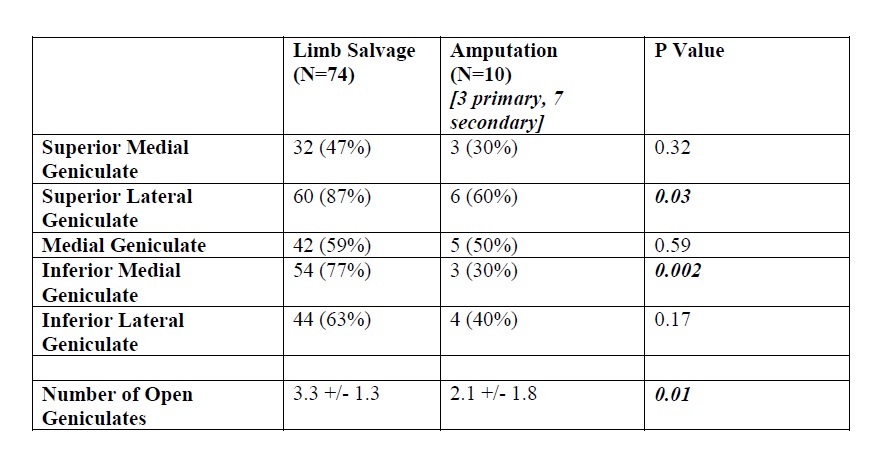|
Back to 2015 Annual Symposium Program
The Impact of Geniculate Artery Collateral Circulation on Lower Limb Salvage Rates in Injured Patients
Anahita Dua, MD, MS, MBA1, Sapan Desai, MD, PhD, MBA2, Sean Johnston, MD3, Naga R. Chinapuvvula, MD3, Charles E. Wade, PhD3, Charles J. Fox, MD4, John B. Holcomb, MD3, Sheila M. Coogan, MD3.
1Medical College of Wisconsin, Milwaukee, WI, USA, 2Southern Illinois University, Springfield, IL, USA, 3University of Texas-Houston, Houston, TX, USA, 4Denver Health Medical Center, Denver, CO, USA.
OBJECTIVES: This study aimed to determine the association between geniculate artery flow on admission CTA and limb salvage outcomes in patients with lower extremity arterial injury.
METHODS: All injured patients at a level I trauma center with CT-angiogram (CTA) confirmed lower extremity common femoral artery (CFA), superficial femoral artery (SFA), profunda femoral artery (PFA), popliteal artery, and/or tibial artery trauma were included. Demographics, injury severity score (ISS), mechanism of injury, physiological parameters, the presence of geniculate artery collateral circulation (superior medial, superior lateral, medial, inferior medial, inferior lateral), and 30 day limb salvage outcome were recorded. Statistical analysis was completed
using descriptive statistics and chi-square tests.
RESULTS: From 2009 to 2012, a total of 84 patients with lower extremity arterial injury underwent diagnostic evaluation with CTA on admission. A total of 10 patients (12%) underwent amputation. Primary amputation was performed in 3 (4%) patients and secondary amputation was performed in 7 (8%) patients. There was no difference in age, gender, ISS, extremity AIS, mechanism of injury, admission systolic blood pressure, heart rate, or respiratory rate, transfusion volume or type of vascular interventions between patients who had successful limb salvage and those who received an amputation. The number of patent geniculate arterial vessels was inversely associated with amputation with 3.3 patent geniculate arteries in the limb salvage group compared to 2.1 in the amputation group (P<0.05). The two geniculate artery vessels that were significantly associated with limb salvage were the superior lateral geniculate and the inferior medial geniculate arteries (p<0.05).
CONCLUSIONS: Geniculate collateral circulation may have an important role in limb salvage after lower extremity vascular injury. The
geniculate arteries that are associated with the highest rates of limb salvage appear to be the superior lateral geniculate and the inferior medical geniculate artery.

Back to 2015 Annual Symposium Program
|







